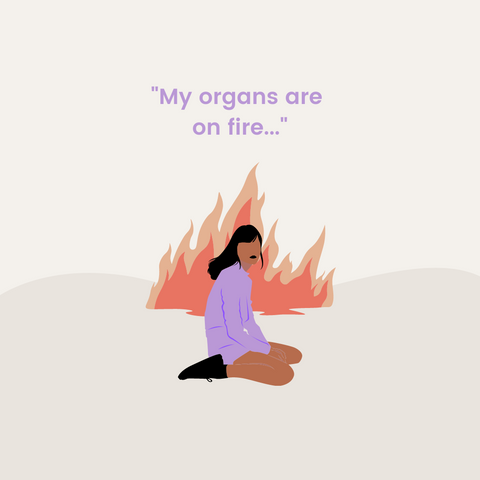My Subtenant Mrs. Endo

Let's talk Endometriosis
“Period pain is normal” – This belief has been branded into my head ever since my first cycle. One out of ten women lives with an unwanted intruder, residing in their body as a destructive subtenant they can’t get rid of. On average, it takes them 10-12 years before they find out that it is everything but normal and they finally dare to knock on the door with the nameplate “Mrs. Endo”. However, that is also the moment they find out that that subtenant’s contract is life-long and they can only learn how to tame it.
Endo What?

Endometriosis is an inflammatory condition where tissue similar to that in the uterus (the endometrium) grows outside of the uterus and attaches itself to the outside of other organs. Naturally, the inner lining of the uterus sheds every month, draining through our vagina. Or in other words: we menstruate. However, the tissue that has been piling up on other organs cannot take the same exit. Instead, it bleeds in our abdomen and is trapped until the body can degrade it. Endometriosis is a chronic and active disease, causing the body to produce more misplaced tissue than it can parallelly degrade.
Both the tissue growing on other organs and the free blood in the abdomen can cause inflammation, swellings, cysts, and adhesions. Most commonly, Endo is found on reproductive organs such as ovaries, fallopian tubes, and the tissue lining the pelvis. However, it is also often detected on the bladder, the bowls, and nerves within the pelvis. The tissue has been found on all organs, even the lungs, and the brain.
What are the Symptoms?
Symptoms can widely differ depending on the place it attaches itself to. Often women report suffering from the following:
- Painful and heavy periods
- Painful sex
- Painful bowel movement and diarrhea (often compared to pressing contractions)
- Typical bloated ‘Endo-Belly’
- Frequent bladder infection
- Pain in the legs and lower back
- Fatigue and brain fog
This can not only affect the function of concerned organs but also on a person’s work, social and personal life. Many develop anxiety and depression due to chronic pain and fatigue.
But what can I do when I think I might have it?
If you experience in the common symptoms of Endometriosis, it is always advised to talk to your Gynaecologist about it:
- Do some research: knowledge is key!
- Make a list of the symptoms you experience and bring it to your appointment
- Name the child by its name: tell your doctor that you think you have Endometriosis
- Request a laparoscopy: the only way to be certain about the diagnosis is to have surgery. If Endo-like tissue is detected it will be removed and tested. Often Endo can not be seen with ultrasounds or other imaging methods.
Be persistent: if you have the feeling your doctor is not taking you seriously, speak up or change your specialist. You can also search for a verified Endo-specialist close to your city.
What can I do to relieve Endo pain?

Five things that work for me:
-
My wireless heating pad is my holy grail. It covers both my abdomen and my lower back. Because it's wireless, I’m not tied to my bed or my sofa and can easily move around in the house or even run errands (if my pain level allows me). Taking warm baths can also do wonders. If you’re stuck in a wave of pain, don’t forget to take care of yourself, even if it’s just a warm bath. Just as the heating pad, the warmth will help to relax your muscles, your nerves, and your mind.
- Making the right food choices can even help to prevent high-intensity pain. Generally, it is suggested to maintain an anti-inflammatory diet. To prevent major flare ups, I’m usually trying to reduce my sugar and caffeine intake, as well as cutting out dairy and meat. Instead, I try to focus on eating fibrous food (such as fruits and vegetables), iron-rich foods for blood loss (such as leafy greens, broccoli, nuts, and seeds), and foods rich in essential fatty acids (such as fish).
- Find the right pain medication for you and keep them on hand. Talk to your doctor about different options of pain-relieving medication or even being referred to a pain specialist. Finding something that works for you might be a process, but don’t get discouraged.
- A trusty period product for those heavy flow days: I use Phia Cup because I only have to think about changing it every 12 hours, which takes away a lot of stress and worries. It's natural, triangular shape does not apply pressure to my often irritated bladder and I simply can’t feel that I am wearing something.
- Make sure to stay hydrated. Many different teas can have anti-inflammatory effects: ginger, turmeric, chamomile, and rooibos are healthy allrounders that can also have a soothing effect on your digestive organs. My favorite tea is green tea. However, I do not recommend it if the Endo irritates your stomach, as it can be a bit harsh. But when in doubt, just water is always a good solution.
How does my Period routine with Endo look like?
Before I knew that my heavy and long bleeding was not normal, I used to wear tampons. Before my actual period starts, I often have a week of spotting followed by more than a week of very heavy bleeding. In the first week, tampons would be painful to insert and get out, and wearing pads all day would irritate me. In the second week, the tampons would barely last two hours and I always had to worry about leakage. But I still used them, because that’s what my mother bought for me, that’s what my big sisters used, and that’s what all my friends used. It was an unconscious habit.
After my diagnosis, I started to research more into alternative period products. I found out that other girls and women were also struggling with their traditional routines. Because I already had to worry about my period so much, I wanted something that I can wear for a long time and that would not irritate me.
At first, the idea of wearing a period cup seemed scary. Wearing a tampon has been painful in the past, so how is it going to work out with this even bigger cup? Phia cup has been the first cup that I tried and I feel comfortable and safe. On the days where I experience light spotting, I like to wear reusable pads at home and the cup when I go out. On the days of my actual period, I insert my cup in the morning and take it out in the evening. It's as easy as that!
Wearing a cup might not work for every Endo patient; however, changing my period routine to what best fits my personal needs made my life less absorbed from worries around my menstruation.
Same, same but different

Even though Endometriosis is so individual in its progress, the beginning of all the stories that one comes across is the same: young girls experiencing pain and other symptoms during their periods, people gaslighting their suffering, and doctor’s eventually prescribing the pill as the only solution. Although birth control might suppress some symptoms, it cannot cure a chronic disease.
If I had the chance to talk to my teenage-self, knowing what I know today, I would not tell her to stop worrying about her middle school crush, that smoking does not make one cool, or that the cool kids are not even that cool… I would simply tell her that period pain is not normal. I would urge her to speak up and be persistent until she is heard.
Endometriosis is considered one of the 20 most painful conditions to exist. Although it's as common as diabetes, diagnosing it still seems to be a long and bumpy road. How is that possible?
- The societal stigma around menstrual health
- Lack of menstrual health education
- Women being taken less seriously when expressing pain
- Poor clinical awareness of the condition and treatments
- Inadequate and often disjointed services
This is why spreading awareness is so important!
Mrs. Endo taking me on a rollercoaster ride

I don’t remember who exactly was holding the hot iron causing the brand mark that would later make me doubt whatever physical pain I experienced, thinking I’m simply too sensitive. Was it my mother who wouldn’t let me stay at home because of my cramps? Was it my sports teacher who required a letter from the doctor for not participating in his class? Or was it my doctor himself, who told me there is nothing wrong? Would it make a difference if I knew?
One thing is certain: living with Endo is a rollercoaster of emotions. Although I was faced with the hard reality of being chronically ill, the diagnosis answered questions I’ve been longing to know the answer to for half of my life. Oddly enough, when I woke up from my first excision surgery, I bursted into tears of happiness: I finally had an explanation for years of suffering and things started to make sense. Many times I doubted my sanity thinking it was all in my head but my pain was suddenly valid to myself and others.
That kind of relief and hope is something I want other girls and women suffering from Endometriosis to have. I want them to be able to get to know their unwanted subtenant and find ways to make peace with her.
Supportive Community
With the Sincerely Phia blog, the Phia team is creating an open space that evokes our community to engage in open and real conversations. We are now opening up our platform for guest writers to amplify more voices. Send us a message here if you would like to be featured on our blog! And don't forget to subscribe to our newsletter below to be notified when we publish a new blog post.




